On the Road is a weekday feature spotlighting reader photo submissions.
From the exotic to the familiar, whether you’re traveling or in your own backyard, we would love to see the world through your eyes.
On the Road: Week of September 7 (5 am)
Albatrossity – Caves and Birds in France, part 1
lashonharangue – Socorro Island, Mexico
?BillinGlendaleCA – Franklin Canyon – Infrared/Visual Pairs
way2blue – Outer Hebrides
Steve from Mendocino – California beach moodsParis After Dark: Week of September 7 (10pm)
opiejeanie – Paris, 2014
Lapassionara – Paris in the daylight
Omnes Omnibus – Paris
BigJimSlade – Paris, 1989
J R in WV – Paris Street ScenesAnd now, let’s get back to Albatrossity. I love just about every one of these pics!
Albatrossity
All of the pictures of Paris were wonderful, and it seems that each submission gave us a unique view of that fabled city. I have never been to Paris, so I appreciated each day of pictures from there.
However, I have been to France. I am not an urbanite (as you might have guessed based on my location here in Flyover Country), so avoiding cities is something I do when I travel as well. In 2005 Elizabeth was working on a series of essays about petroglyphs, cave art, and the relationships that our ancestors had with the animate world they lived in. That work is collected in her award-winning 2008 book, “In the Mind’s Eye”. So we went to the part of France that has prehistoric art in caves and grottoes to see some of that, as well as to the Camargue, the wildlife-rich delta of the Rhone. Here are some images from that memorable tour of cave art and birds of France.
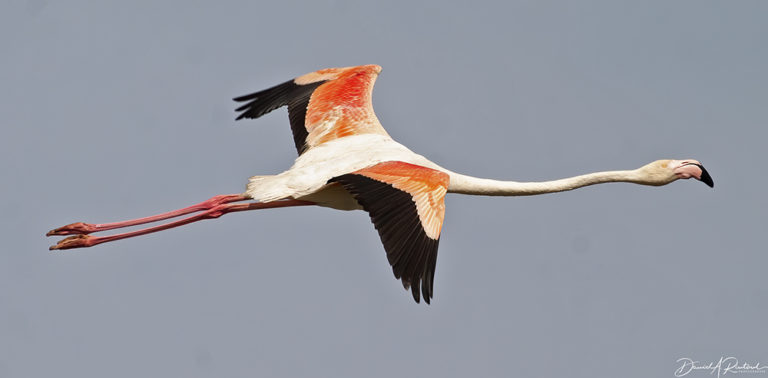
We flew into Nice and then immediately drove to the Parc Ornithologique du Pont de Gau, in the heart of the Camargue, where we stayed in a lovely 2-star hotel, the Hostellerie du Pont de Gau. In our visit we made a point of staying in smaller hotels and eating in 4-5 star restaurants, the logic being that if the food and wine were wonderful, we would sleep well regardless of the quality of the bed. This strategy (quickly dubbed the “waddle and sleep”) worked well here, since the restaurant at the hotel was fabulous. The next morning we woke up to find flamingos flying past the windows of our room.
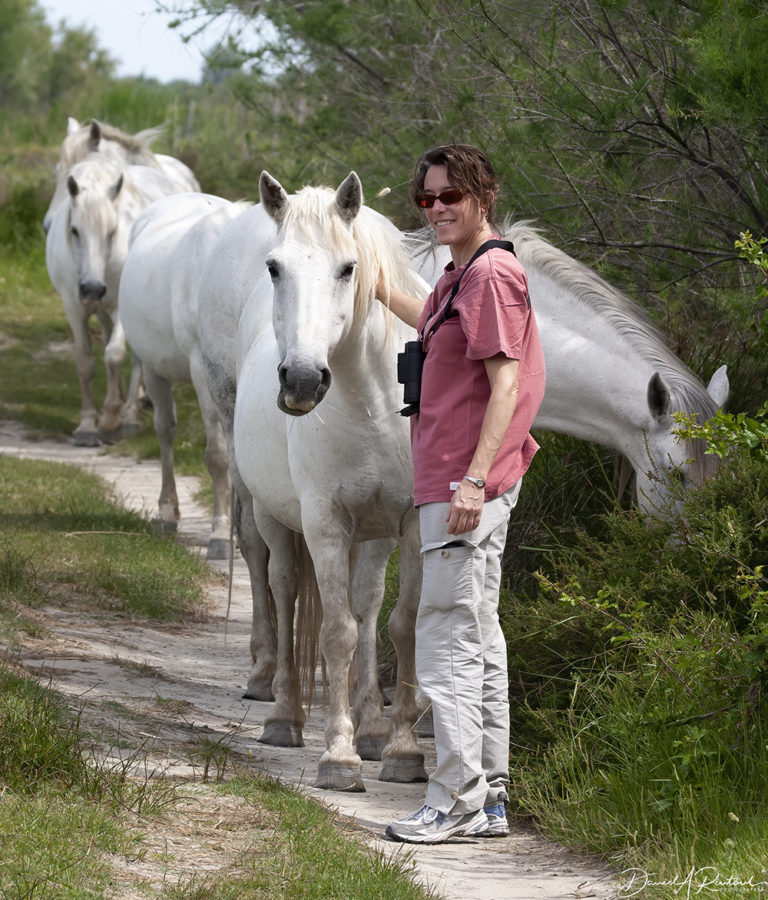
The trails at the Parc were great for wildlife viewing, hiking, and horse-petting. Here’s Elizabeth with some of the famous white horses of the Camargue. This is considered to be one of the oldest breeds of horses in the world, small but sturdy, and also very friendly in this case.
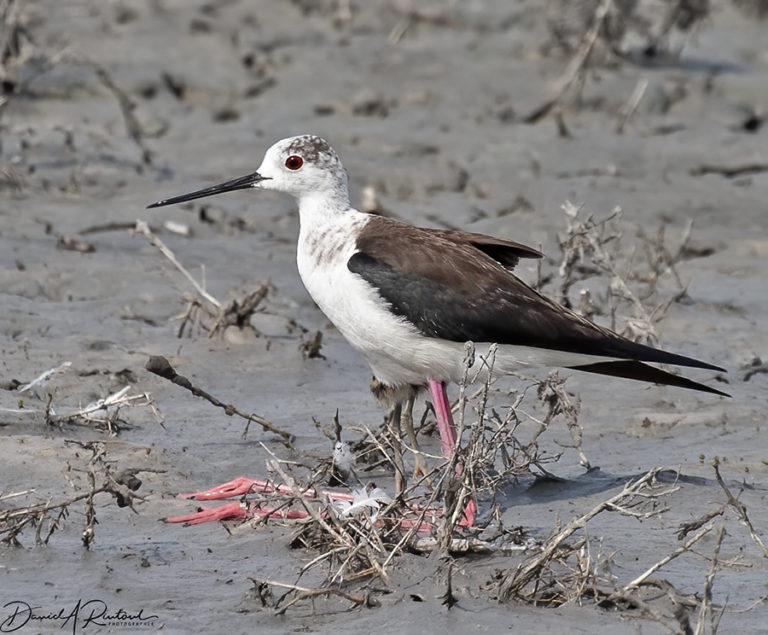
It was nesting season for lots of waterfowl in the Camargue, and young birds were abundant. Here is a Black-winged Stilt, crouching down to shield the downy youngster from the prying eyes of the photographer. You can see the legs of the young bird, which are not quite as long as those of the adult, underneath the body of the parent bird.
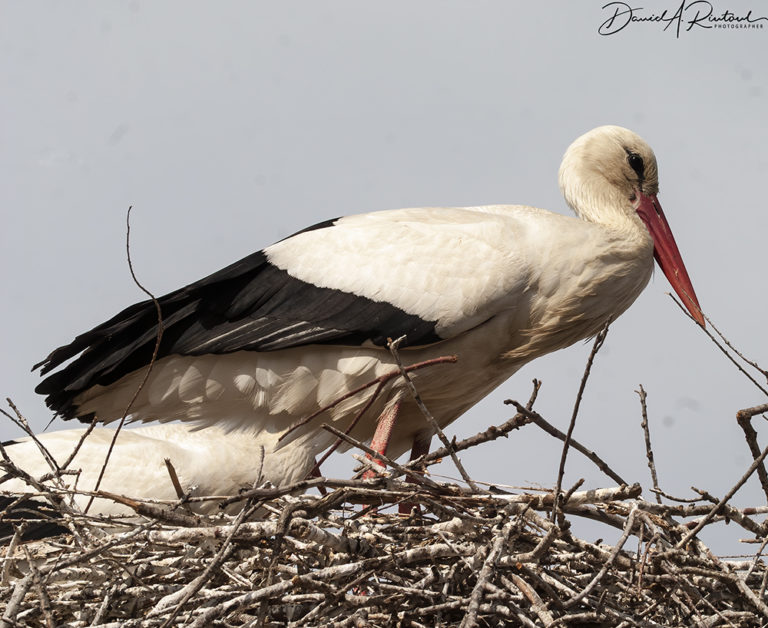
White Storks were on nests as well; this one was just across the road from the hotel.
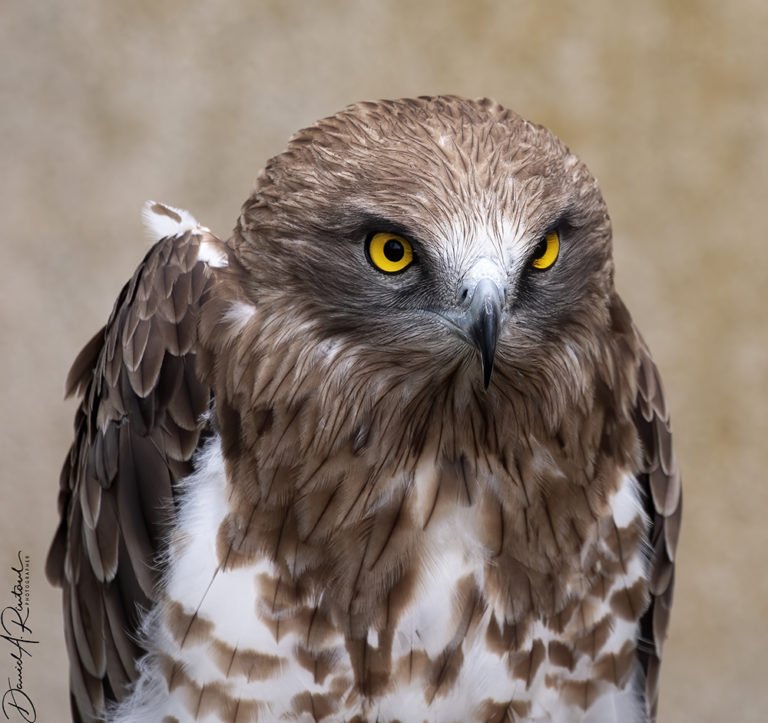
One of the local raptors, this Short-toed Snake-eagle was content to just glare at me. I was happier than usual that I was not a snake.
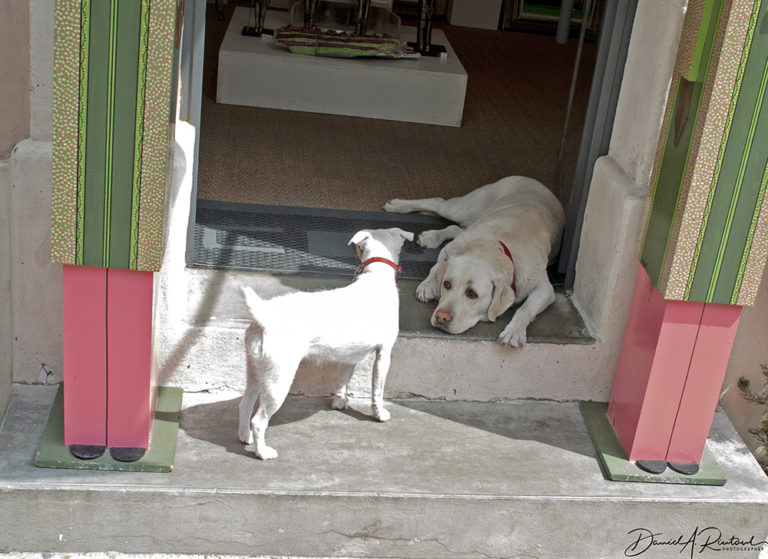
One of the nearby towns had a colorful doorway that was hosting these two dogs, I could not tell if one or both of them lived there, but since the BJ crowd loves dogs and other pets, I thought that this photo would be appreciated here. This medieval walls surrounding this town are very well-preserved; it’s worth a visit!
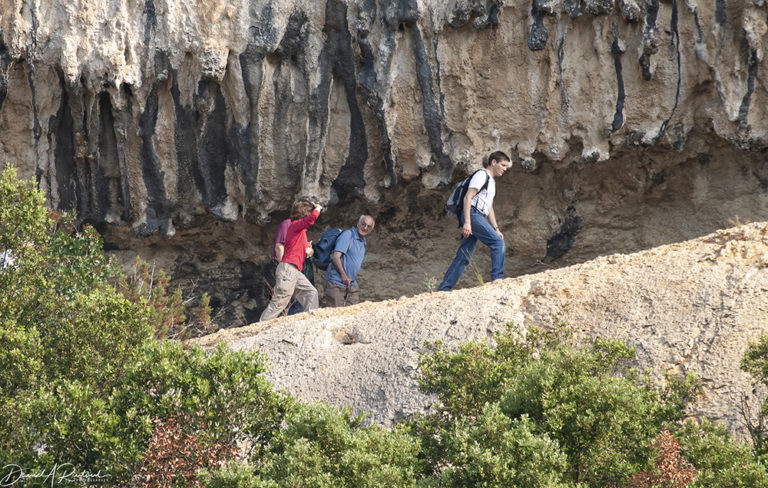
After a couple of days in the Camargue, we headed north to the Ardeche River, site of a cave that Elizabeth was absolutely thrilled to have gained permission to enter, the Chauvet-Pont-d’Arc Cave. In correspondence with archaeologist Jean Clottes, whose study of this famous cave has revealed much about the humans who inhabited it 32,000 years ago, she got an appointment to meet with him and other archaeologists for a planned trip into the cave. It is otherwise closed to visitors (I didn’t get to go along!), so this was a very special (pinch me, is this real?) treat. This is my photo of Elizabeth, Jean and the others trekking up to the cave entrance, high above the Ardeche River. Her trip into the cave is chronicled in an essay published in Notre Dame Magazine; lots more information about this fabulous discovery can be found here. You may also have seen Werner Herzog’s 3D movie about Chauvet, “Cave of Forgotten Dreams”.
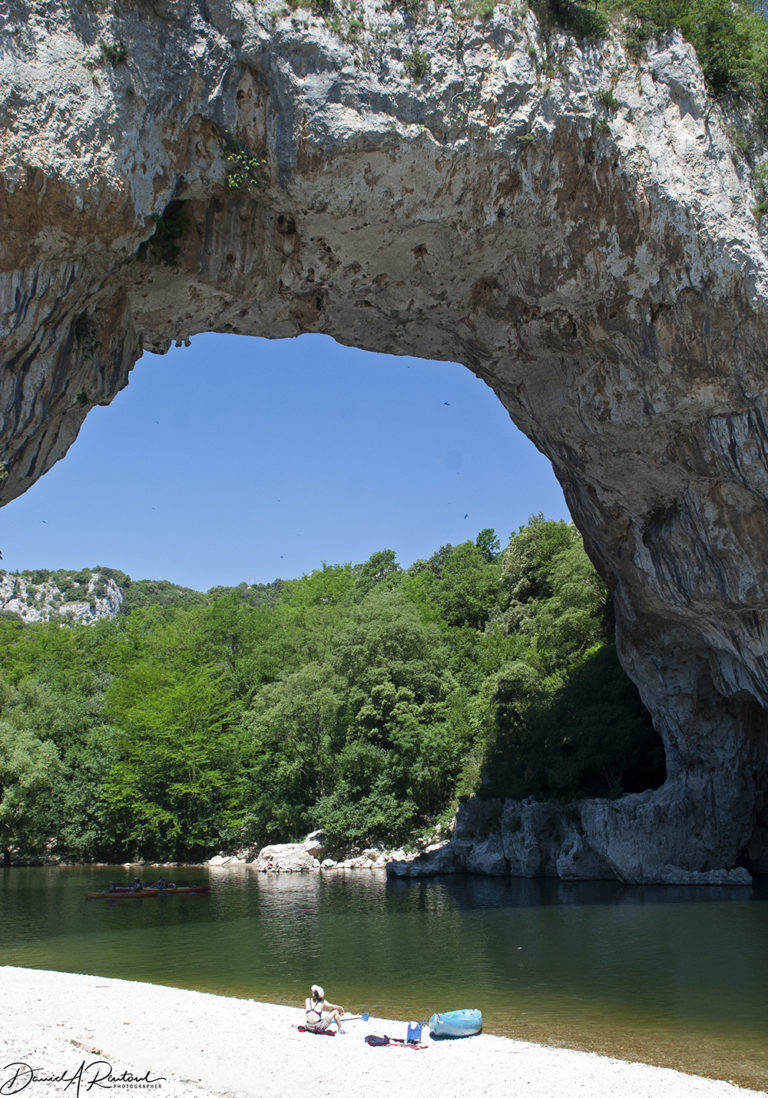
The other noteworthy feature of this region is this natural arch above the Ardeche, which is relatively close to Chauvet Cave. We rented a canoe, floated down the river, and had a picnic lunch under the arch.

Mary G
What a lovely trip. Albatrossity is a good antidote to the Monday blahs. I wish I could be picnicking beneath that arch right now; it looks so serene. Appreciate both the dogs and horses, all white.
There go two miscreants
Very cool! I definitely did not think about France in connection with wildlife, although of course I was aware of the cave paintings.
JPL
Wonderful pictures and the eagle gives special meaning to if looks could kill.
Lapassionara
These are such a treat. I was able to see some of the caves in the Dordogne region. The pictures of them in art history books do not do them justice.
Albatrossity
@Lapassionara: We visited caves in the Dordogne region as well; that part of the trip is included in next Monday’s continuation of this series.
And no, mere pictures cannot possibly depict the reality of those cave art installations. As you know, the artists used the 3D substrate of the cave walls to their advantage, so that the creatures have depth and even motion. That will never show up in a 2D print in an art book.
rikyrah
Beautiful pictures ?
MazeDancer
Great photos!
p.a.
Aren’t there concerns abt photographing the cave art? Light damage? Does digital tech lessen the damage concerns?
Albatrossity
@p.a.: Lighting can lead to algal growth that can damage the paintings. But light from a 1/30,000 sec camera flash, or even many camera flashes, would not do that.
I suspect that the ban on cameras in those caves is more economic than ecological. Copyrights to cave painting images are owned by the government of France, and if you want to use one of those in a book or other commercial enterprise, you have to pay them for the privilege.
Wag
Phenomenal. Especially the photo of the flamingo!
If you were in the States, the final picture would be termed a natural bridge, because it spans a stream bed. Arches form alongside canyon walls, and not over bodies of water. Bridges are much more rare.
Albatrossity
@Wag: The French name for this feature is Pont-d’Arc. Since pont = bridge, and arc = arch or bow, I guess they have both of those options covered!
WaterGirl
@JPL: That owl, wow! That owl has that look down pat, even outdoing Tom Levenson’s Tikka!
WaterGirl
Love those horses! And the dog, with Dog, Jr.
eclare
Looks like a great trip!
donatellonerd
absolutely lovely pictures. we were in the Camargue for a week the summer of 2019 … in late August. my daughter named the house we were in Mosquitoville.
Miss Bianca
Wow, I’ve always wanted to go to the Camargue to see the wild white horses, but apparently I should also be looking for the spectacular bird life! Thanks, Albatrossity! If I ever get to travel overseas again, this part of France is going on the bucket list!
West of the Rockies
Oh, I’m so glad I popped onto this thread today! Those are all compelling, beautiful photographs.
arrieve
A part of France I’ve never visited so a welcome morning treat. I’ve always wanted to see the cave art; didn’t realize I could pet horses on the same trip.
Albatrossity
@donatellonerd: Yeah, we were there in early June, so the mosquitoes hadn’t quite hit their stride yet. I’d recommend that timing!
Mr. Prosser
Short-toed Snake-eagle sounds like a Joe Biden insult.
meander
Thanks for the superb photos and stories. How wonderful to see a flamingo!
For a quirky cinematic view of the French countryside and small towns, I recommend Faces Places, a French documentary film from 2017 by legendary filmmaker Agnes Varda (she worked with Goddard & other New Wave people), and street artist/photographer JR. They travel around France to visit small villages and take pictures of people (or animals), and then make interesting art. The film is slow and rambling, full of creativity and randomness. A good tonic for today’s toxicity. Perhaps it’s streaming on a service you subscribe to (Kanopy is one service that I know has it. It’s also in the Netflix DVD library).
stinger
Dave, your bird photos capture their conformation, coloration, movement, and even personality — just remarkable. And I’ve just spent an hour “touring” the Chauvet Cave. Thanks for that link, and the one to your wife’s great essay.
Betsy
Amazing. Thank you for these.
I propose that all the birdwatching/naturalizing/botanizing-minded BJ’ers go on a loosely organized group vacation after the Thing is resolved. Who’s in??
BigJimSlade
All great stuff, but that flamingo and the snake-eagle – wow!
J R in WV
@Betsy:
I’m in…
I spent a couple of hours in the web site for the cave, and read the E. Dobbs article as well, all fascinating! Wife and I visited the general area on an AIA sponsored tour led by Paul Bahn, who appeared to be personally acquainted with every speck of pigment in every cave.
We met other famous archaeologists studying at digs, leading other tours, etc. I have two files with hundreds of photos have done several On the Road sets, the Parisian street scenes coming up on Friday evening were taken on the last couple of days of that trip… we decided to add a couple of days to see Paris, so glad we spent time at Notre Dame back in the day — those pics have been On the Road not long after the tragic fire.
Albatrossity
@Betsy: Well, since I’m about as loosely organized as anybody can be, count me in!
Tehanu
Wonderful photos, thank you!
WaterGirl
This is an awesome sentence: